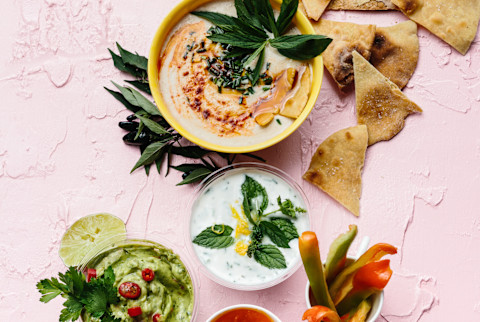The Easiest Way To Boost The Antioxidant Power Of Everything You Eat This Summer

You're likely already well aware of the health benefits of summer staples like watermelon (all that lycopene!) and fresh berries (so many polyphenols1!). But did you know there's a sleeper hit among the seasonal bounty that can make everything you eat a little bit healthier?
We're talking, of course, about herbs, the massive antioxidant boosters that make everything they touch taste 10 times more delicious. Herbs are rich in phytochemicals like phenolic acids, flavonoids, and terpenes that pack a ton of health benefits into each bite. Here's a rundown of some of our favorites and exactly how to use them to amp up the nutritive properties of everything you eat.
Basil
Basil includes a variety of phytochemicals, including monoterpenoids (e.g., linalool, camphor), phenylpropanoids (e.g., eugenol, methyleugenol, estragole, and methyl cinnamates), and sesquiterpenoids. These have been shown in a number of studies to balance blood sugar, boosting the immune system, alleviate stress and anxiety, enhance memory, and improve oral and skin health. Basil has a mildly sweet, peppery flavor that works well with almost any fruit (chop some up and add it to a stone fruit salad—you're welcome!) and torn and tossed into salads. It's most famous for being the base of pesto, which, in addition to being a perfect pasta pairing, can be used as a dip for crudités and crackers or pizza sauce.
Mint
Fresh mint is like a cool breeze on a hot day: a welcome (and often necessary) addition to the sweltering season. It's most famous for its gut-soothing properties, having been shown in a number of2 studies3 to help with IBS, indigestion, and bloat reduction. You can beat the heat Moroccan-style by brewing a tea with fresh mint leaves—in the largely desert country, they find sipping the hot, minty beverage to be conversely more cooling than imbibing an icier drink. Mint is also a welcome addition to salads or can be made into a wonderful sauce with some garlic, vinegar, sea salt, and olive oil to top grass-fed grilled steaks or pasture-raised chicken.
Dill
Ah, dill, the most underappreciated of herbs. Dill contains carvone and limonene, which have both been shown4 to have powerfully anti-inflammatory effects in the body. They're also fat-soluble, which means that dill should ideally be eaten with a healthy fat in order to achieve the most benefits (a good page to take from the Mediterranean diet, which almost always pairs dill with extra-virgin olive oil). Dill is bright, lemony, and little bitter, with a hint of a celery or anise-type flavor. Its feathery leaves make a beautiful addition to salads or grain-based dishes; paired with lemon juice and zest and some olive oil (its two best friends), it makes a perfect marinade for slow-roasted wild-caught salmon.
Chives
Often confused with their less delicate cousins, green onions, chives are actually an herb (while green onions are, well, onions). They are, however, in the allium family (that is, the same family as onions and garlic) and have a far more mild, sweeter version of the same umami-rich flavor that garlic and onions bring to the table. They also contain allyl sulfides, which have been shown to help with digestive issues5, and the same allicin as garlic, which has been shown to be powerfully antibacterial. Moreover, because of their lighter flavor, chives are far more versatile than other allium family members. They work beautifully in salads, folded into soft-scrambled eggs, or as a finisher on summery pastas.
Oregano
Oregano is one of the oft-cited foods by experts accounting for the mega-health benefits of the Mediterranean diet, and research certainly backs this up: Used by Hippocrates as an antiseptic, oregano boasts beta-caryophyllin (E-BCP), a powerfully anti-inflammatory dietary cannabinoid6 that may harness much of the same benefits of more trendy compounds like CBD. Unlike many herbs, which can be assimilated into a wide variety of dishes, oregano has a bold, astringent flavor that doesn't fade into the background of food. Add it to some tacos or a bold pasta sauce, or sprinkle some leaves on top of pizza for an herby, vegetal note. You can also do as the Greeks do and steep some oregano tea, so you can enjoy the herb's many benefits with every sip!
